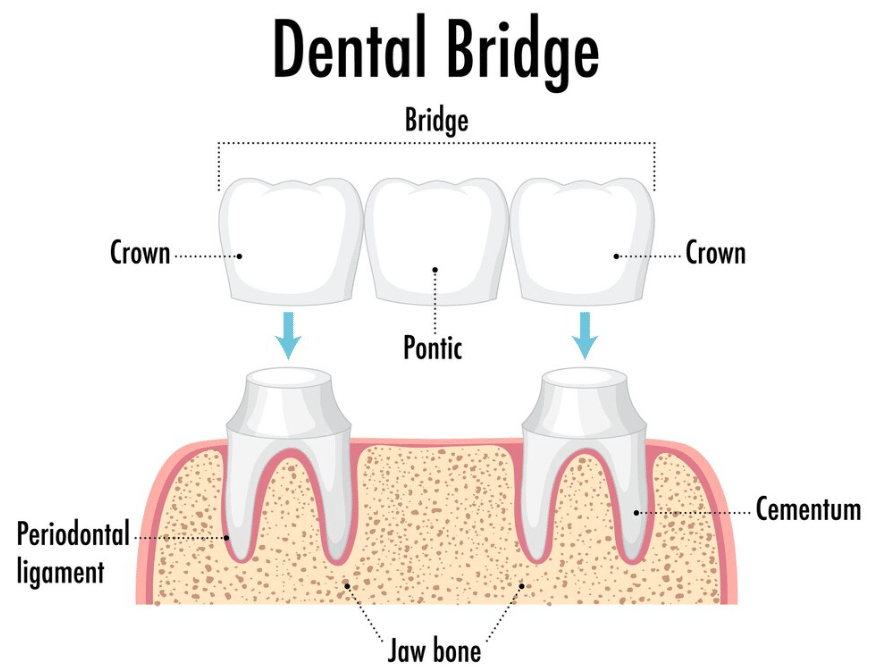What is Dental Bridge?
Dental bridges are a form of restorative dentistry used to replace one or more missing teeth. They literally “bridge” the gap created by absent teeth. A bridge is made up of two or more crowns for the teeth on either side of the gap, termed anchoring teeth or abutments, and a false tooth or teeth in between, called pontics. These false teeth can be made of gold, alloys, porcelain, or a combination of these materials.
A dental bridge is a fixed dental restoration used to replace one or more missing teeth by bridging the gap between two existing teeth. Here’s a detailed explanation:
- Abutment Teeth: These are the natural teeth or dental implants on either side of the gap. They serve as the anchors for the bridge.
- Pontics: These are the artificial teeth that replace the missing teeth. They are attached to the crowns on the abutment teeth.

Are Dental Bridges safe long term?
Yes, dental bridges are considered a safe and long-term solution for missing teeth when appropriately fabricated and placed. With good oral hygiene and regular dental check-ups, a bridge can last for many years, often ranging between 10 to 15 years or even longer. Like natural teeth, the surrounding structures and the health of the anchored teeth play a significant role in the bridge’s longevity. It’s important to maintain good oral health to ensure the supportive teeth remain strong.
Types of Dental Bridges
- Traditional Bridges: The most common type, consisting of a crown for the tooth on either side of the gap, with a pontic in between. These are made of ceramics or porcelain fused to metal.
- Cantilever Bridges: Used when there are adjacent teeth on only one side of the missing tooth or teeth. It’s less common and not recommended for areas that bear a lot of biting pressure, like the back of the mouth.
- Maryland Bonded Bridges (Resin-bonded Bridges): Made up of a metal or porcelain framework with wings on each side bonded to the existing teeth. A pontic is then attached to this framework.
- Implant-supported Bridges: As the name suggests, these bridges are supported by dental implants rather than crowns or frameworks. Typically, one implant is surgically placed for every missing tooth, holding the bridge in position.
Why you should choose Turkey for Dental Bridges Treatment?
Turkey, particularly renowned centers like the Dr. Yetkin Bayer Clinics, has become a leading destination for dental tourism, and here’s why:
- Advanced Technology: Turkish dental clinics are equipped with the latest dental technology, ensuring precision and high-quality treatments.
- Expertise: Dentists in Turkey are highly trained, with many having international exposure and certifications. They are adept at handling complex dental procedures, including bridge placements.
- Cost-Effective: One of the major reasons many patients opt for treatment in Turkey is the cost advantage. Dental procedures, including bridges, are offered at a fraction of the cost compared to many Western countries without compromising on quality.
- Cultural and Historical Experiences: Beyond dental treatments, Turkey offers a rich cultural experience, beautiful landscapes, and historic sites. Many patients combine their dental trips with a vacation.
- International Standards: Clinics like Dr. Yetkin Bayer Clinics adhere to international standards of sterilization, safety, and patient care, ensuring that patients receive the best treatment in a safe environment.
FAQ about Dental Bridge
A dental bridge works by using the abutment teeth as supports to hold the pontics in place, effectively “bridging” the gap created by missing teeth.
Good candidates are those with one or more missing teeth, healthy abutment teeth or sufficient bone structure for implants, and a commitment to maintaining good oral hygiene.
With proper care, dental bridges can last between 5 to 15 years or longer.
Maintain good oral hygiene by brushing twice a day, flossing daily (using a floss threader for the bridge), and having regular dental check-ups and cleanings.
Dental bridges are fixed prosthetics and are not removable by the patient. They are designed to remain in place permanently, though a dentist can remove them if necessary for maintenance or replacement.
Yes, dental bridges are considered a safe and long-term solution for missing teeth when appropriately fabricated and placed. With good oral hygiene and regular dental check-ups, a bridge can last for many years, often ranging between 10 to 15 years or even longer. Like natural teeth, the surrounding structures and the health of the anchored teeth play a significant role in the bridge’s longevity. It’s important to maintain good oral health to ensure the supportive teeth remain strong.
The procedure to place dental bridges is typically carried out under local anesthesia, ensuring the patient feels minimal to no pain during the process. There might be a sensation of pressure, but actual pain is rare. Post-procedure, like after most dental restorations, some tenderness or sensitivity in the surrounding area might be experienced, but this usually resolves within a few days. Any discomfort can generally be managed with over-the-counter painkillers and by following aftercare instructions provided by the dentist.









